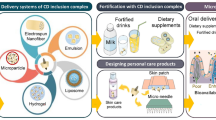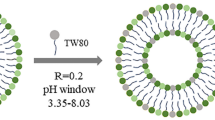Abstract
The aim of this study was to increase the stability and water solubility of fragrance materials, to provide controlled release of these compounds, and to convert these substances from liquid to powder form by preparing their inclusion complexes with cyclodextrins (CDs). For this purpose, linalool and benzyl acetate were chosen as the fragrance materials. The use of β-cyclodextrin (βCD) and 2-hydroxypropyl-β-cyclodextrin (2-HPβCD) for increasing the solubility of these 2 fragrance materials was studied. Linalool and benzyl acetate gave a B-type diagram with βCD, whereas they gave an AL-type diagram with 2-HPβCD. Therefore, complexes of fragrance materials with 2-HPβCD at 1:1 and 1:2 molar ratios (guest:host) were prepared. The formation of inclusion complexes was confirmed using proton nuclear magnetic resonance (1H-NMR) spectroscopy and circular dichroism spectroscopy. The results of the solubility studies showed that preparing the inclusion complex with 2-HPβCD at a 1:1 molar ratio increased the solubility of linalool 5.9-fold and that of benzyl acetate 4.2-fold, whereas the complexes at a 1:2 molar ratio increased the solubility 6.4- and 4.5-fold for linalool and benzyl acetate, respectively. The stability and in vitro release studies were performed on the gel formulations prepared using uncomplexed fragrance materials or inclusion complexes of fragrance materials at a 1:1 molar ratio. It was observed that the volatility of both fragrance materials was decreased by preparing the inclusion complexes with 2-HPβCD. Also, in vitro release data indicated that controlled release of fragrances could be possible if inclusion complexes were prepared.
Similar content being viewed by others
References
Healy LL. Gelled emollient systems for controlled fragrance release and enhanced product performance.Cosmet Toilet. 2002;117:47–54.
Matsuda H, Ito K, Fujiwara Y, et al. Complexation of various fragrance materials with 2-hydroxypropyl-β-cyclodextrin.Chem Pharm Bull (Tokyo). 1991;39:827–830.
Tanaka M, Matsuda H, Sumiyoshi H, et al. 2-Hydroxypropylated cyclodextrins as a sustained release carrier for fragrance materials.Chem Pharm Bull (Tokyo). 1996;44:416–420.
Amann M, Dressnandt G. Solving problems with cyclodextrins in cosmetics.Cosmet Toilet. 1993;108:90–95.
Loftsson T. Cyclodextrins in skin delivery.Cosmet Toilet. 2000;115:59–66.
Del Valle EMM. Cyclodextrins and their uses: a review.Process Biochem. 2004;39:1033–1046.
Motwani M, Zatz JL. Applications of cyclodextrins in skin products.Cosmet Toilet. 1997;112:39–47.
Loftsson T, Másson M. Cyclodextrins in topical drug formulations: theory and practice.Int J Pharm. 2001;225:15–30.
Másson M, Loftsson T, Másson G, Stefánsson E. Cyclodextrins as permeation enhancers: some theoretical evaluations and in vitro testing.J Control Release. 1999;59:107–118.
Loftsson T, Ólafsdóttir BJ, Bodor N. The effects of cyclodextrins on transdermal delivery of drugs.Eur J Pharm Biopharm. 1991;37:30–33.
Rogers K. Controlled release technology and delivery systems.Cosmet Toilet. 1999;114:53–60.
Buschmann HJ, Schollmeyer E. Applications of cyclodextrins in cosmetic products: a review.J Cosmet Sci. 2002;53:185–191.
Duchene D, Wouessıdjewe D. Physicochemical characteristics and pharmaceutical uses of cyclodextrin derivatives, Part I.Pharm Technol. 1990;14:26–34.
Çelebi N, Kışlal Ö, Tarımcı N. The effect of β-cyclodextrin and penetration additives on the release of naproxen from ointment bases.Pharmazie. 1993;48:914–917.
Anadolu RY, Sen T, Tarımcı N, Birol A, Erdem C. Improved efficacy and tolerability of retinoic acid in acne vulgaris: a new topical formulation with cyclodextrin complex.J Eur Acad Dermatol Venereol. 2004;18:416–421.
Matsuda H, Ito K, Taki A, Uejima O, inventors. Shiseido Company Ltd., assignee. Cosmetic composition containing inclusion product with hydroxyalkylated cyclodextrin. US patent 5 447 920. September 5, 1995.
Higuchi T, Connors KA. Phase-solubility techniques.Adv Anal Chem Instrum. 1965;4:117–210.
Ajısaka N, Hara K, Mikuni K, Hara K, Hashimoto H. Effects of branched cyclodextrins on the solubility and stability of terpenes.Biosci Biotechnol Biochem. 2000;64:731–734.
Lu CS, Hu CJ, Yu Y, Meng QJ. The inclusion compounds of β-cyclodextrin with 4-substituted benzoic acid and benzaldehyde drugs studied by proton nuclear magnetic resonance spectroscopy.Chem Pharm Bull (Tokyo). 2000;48:56–59.
Choi HS, Knevel AM, Chang C. Molecular complexation: β-cyclodextrin and benzaldehyde inclusion complex.Pharm Res. 1992;9:690–693.
Anguıano-Igea S, Otero-Espınar FJ, Vıla-Jato JL, Blanco-Mendez J. Interaction of clofibrate with cyclodextrin in solution: phase solubility1H NMR and molecular modelling studies.Eur J Pharm Sci. 1997;5:215–221.
Frank SG. Inclusion compounds.J Pharm Sci. 1975;64:1585–1604.
Szejtli J.Cyclodextrin Technology. Dordrecht, The Netherlands: Kluwer Academic Publishers; 1988.
Bekers O, Uıjtendaal EV, Beıjnen JH, Bult A, Underberg WJM. Cyclodextrins in the pharmaceutical field.Drug Dev Ind Pharm. 1991;17:1503–1549.
Duchene D, Wouessidjewe D, Poelman MC. Dermal uses of cyclodextrins and derivatives. In: Duchêne D, ed.New Trends in Cyclodextrins and Derivatives. Paris, France: Editions de Sante; 1991:302.
Frömming KH, Szejtli J.Cyclodextrins in Pharmacy. Dordrecht, The Netherlands: Kluwer Academic Publishers; 1994.
Author information
Authors and Affiliations
Corresponding author
Additional information
Published: October 19, 2007
Rights and permissions
About this article
Cite this article
Numanoğlu, U., Şen, T., Tarimci, N. et al. Use of cyclodextrins as a cosmetic delivery system for fragrance materials: Linalool and benzyl acetate. AAPS PharmSciTech 8, 85 (2007). https://doi.org/10.1208/pt0804085
Received:
Revised:
Accepted:
DOI: https://doi.org/10.1208/pt0804085




